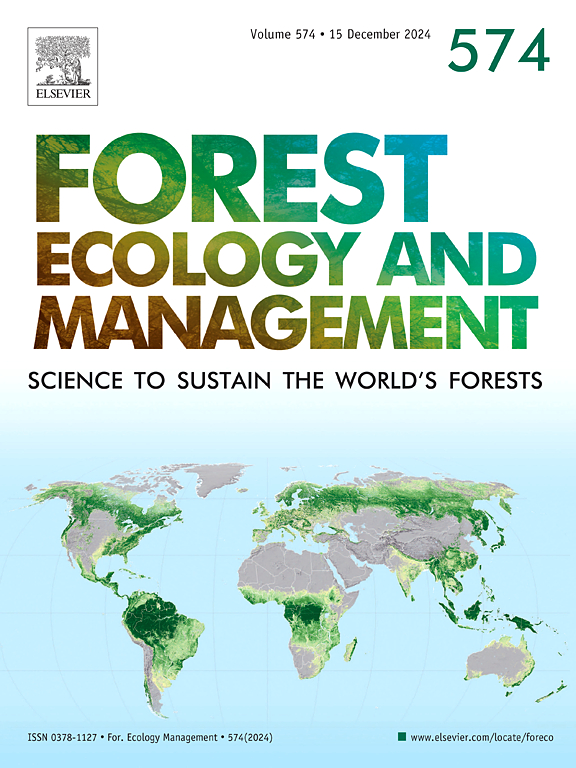多少才算太多?生物量收获、场地准备强度和木灰应用如何改变二次生长北方杰克松林的植物群落恢复?
IF 3.7
2区 农林科学
Q1 FORESTRY
引用次数: 0
摘要
有人建议采取更密集的森林管理办法,以满足对林业产品,特别是对可再生能源日益增加的需求。在本研究中,我们比较了加拿大安大略省北部一次生林(Pinus banksiana Lamb.)植物群落组成、结构和功能对不同造林方式梯度的响应。生物量收获和场地准备干扰强度的五种组合,包括种植后6年以前收获的着陆(木材加工区)进行了比较。此外,还研究了两种木材灰分改性处理对木材灰分的改善效果。我们发现,大量生物量收获、森林地面移除和高度土壤压实的强化处理改变了植物群落组成。强化处理的植物群落分类多样性和功能多样性较低,植被覆盖度低,矮、不耐荫的物种较多,垂直结构不发达。低强度处理,包括树长采伐和两种灰分修正处理,与全树采伐处理具有相似的分类和功能组成,由维管和非维管植物物种组成,通常与成熟的北方森林群落有关。这些发现强调了建立生物量收获准则的重要性,这些准则应保护生态上重要的条件和属性,以保护生物遗产和促进生态系统水平的恢复,包括尽量减少森林地面干扰,保持细木屑和粗木屑的平衡。本文章由计算机程序翻译,如有差异,请以英文原文为准。
How much is too much? How do biomass harvesting, site preparation intensity, and wood ash applications alter plant community recovery of a second growth boreal jack pine forest?
More intensive forest management practices have been suggested as a means to meet increasing demands for forestry products, particularly those for renewable energy. In this study, we compare plant community composition, structure, and function in response to a gradient of silvicultural practices in a second growth jack pine forest (Pinus banksiana Lamb.) in northern Ontario, Canada. Five combinations of biomass harvest and site preparation disturbance intensities, including landings (wood processing area) from the previous harvest were compared six years after planting. Additionally, two wood ash amendment treatments were included to explore the ameliorative effects of ash application. We found more intensive treatments that had large amounts of biomass harvested, forest floor removal, and high soil compaction, changed plant community composition. The plant communities of the intensive treatments had low taxonomic and functional diversity, and were characterized by low vegetation cover, a high prevalence of short, shade intolerant species, and an underdeveloped vertical structure. The less intensive treatments, including Tree-length harvest and the two ash amendment treatments, had similar taxonomic and functional composition to the Full-tree harvest treatment and were comprised of vascular and non-vascular plant species typically associated with mature boreal forest communities. These findings underscore the importance of establishing biomass harvest guidelines that preserve ecologically significant conditions and attributes to safeguard biological legacies and facilitate ecosystem-level recovery, including minimizing forest floor disturbance and maintaining a balance of fine and coarse woody debris.
求助全文
通过发布文献求助,成功后即可免费获取论文全文。
去求助
来源期刊

Forest Ecology and Management
农林科学-林学
CiteScore
7.50
自引率
10.80%
发文量
665
审稿时长
39 days
期刊介绍:
Forest Ecology and Management publishes scientific articles linking forest ecology with forest management, focusing on the application of biological, ecological and social knowledge to the management and conservation of plantations and natural forests. The scope of the journal includes all forest ecosystems of the world.
A peer-review process ensures the quality and international interest of the manuscripts accepted for publication. The journal encourages communication between scientists in disparate fields who share a common interest in ecology and forest management, bridging the gap between research workers and forest managers.
We encourage submission of papers that will have the strongest interest and value to the Journal''s international readership. Some key features of papers with strong interest include:
1. Clear connections between the ecology and management of forests;
2. Novel ideas or approaches to important challenges in forest ecology and management;
3. Studies that address a population of interest beyond the scale of single research sites, Three key points in the design of forest experiments, Forest Ecology and Management 255 (2008) 2022-2023);
4. Review Articles on timely, important topics. Authors are welcome to contact one of the editors to discuss the suitability of a potential review manuscript.
The Journal encourages proposals for special issues examining important areas of forest ecology and management. Potential guest editors should contact any of the Editors to begin discussions about topics, potential papers, and other details.
 求助内容:
求助内容: 应助结果提醒方式:
应助结果提醒方式:


